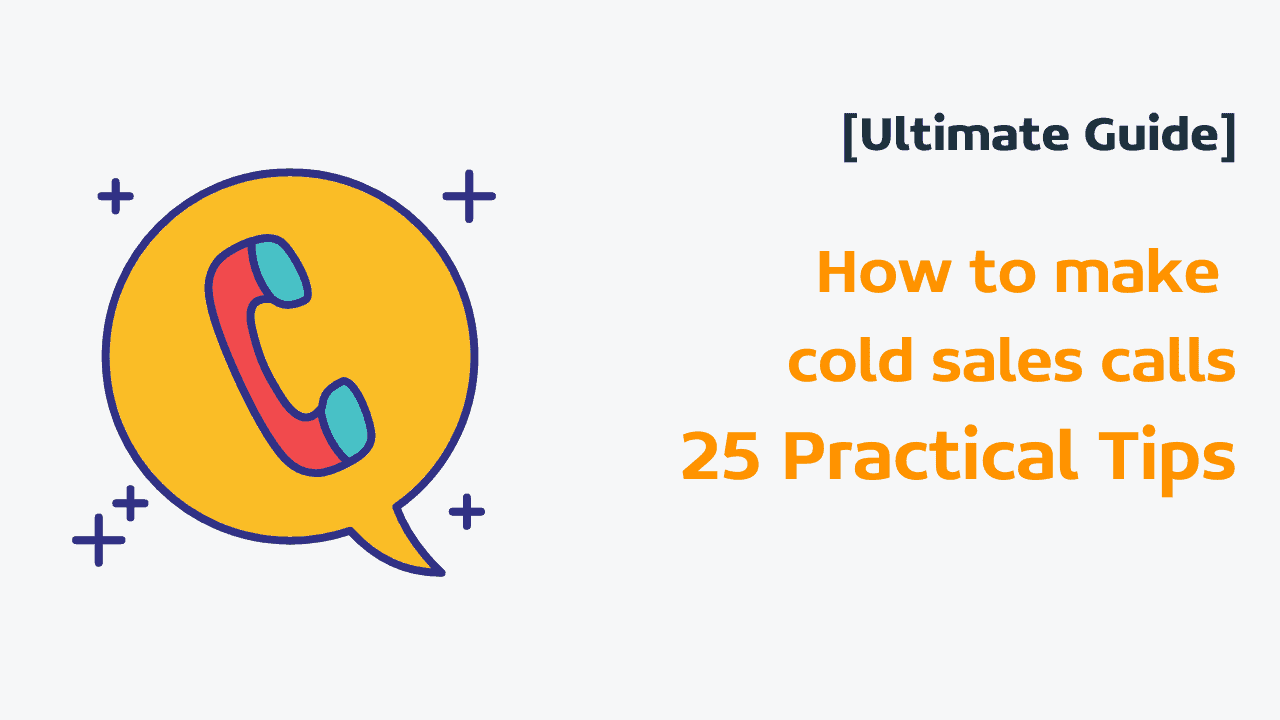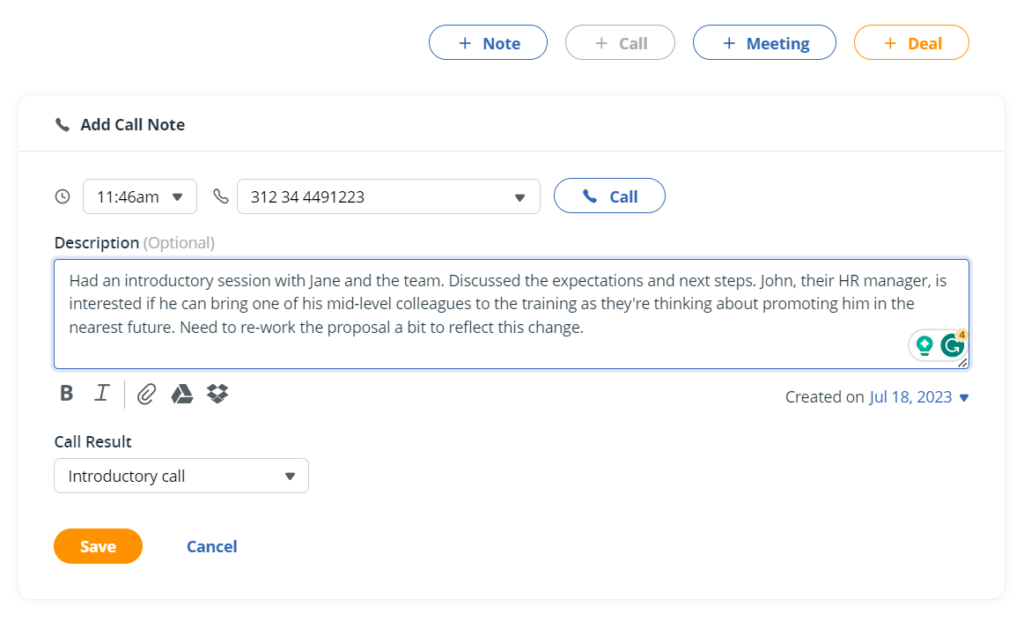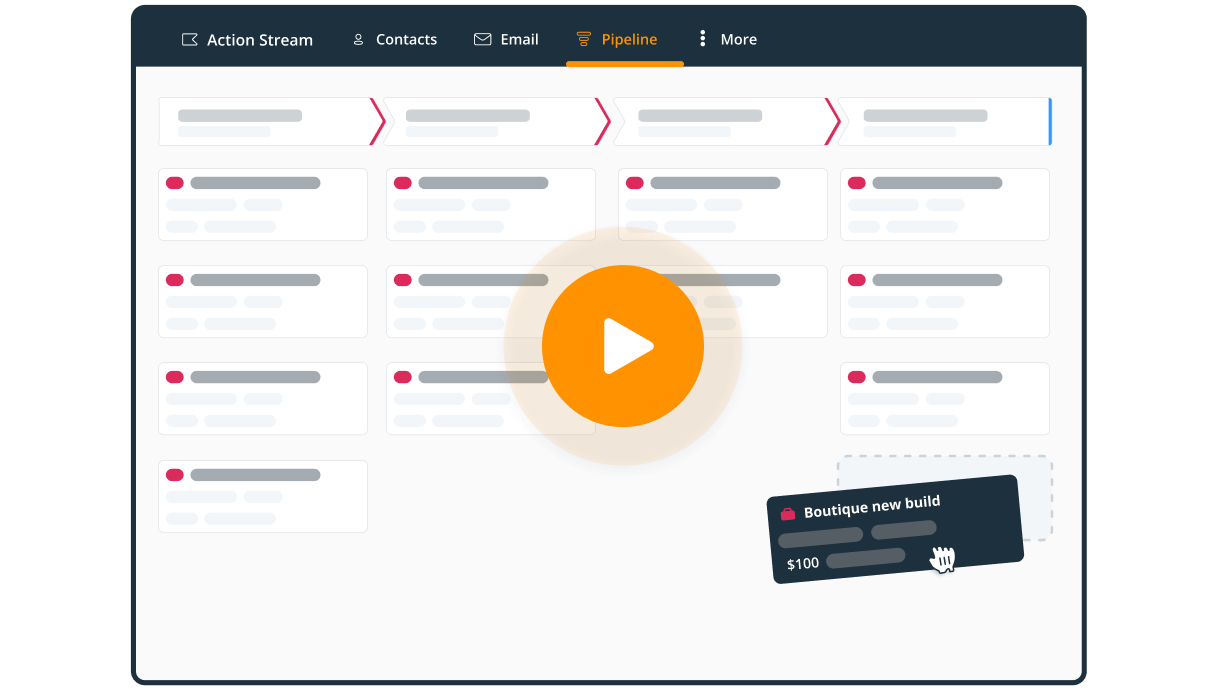
Reaching out to potential clients and partners is a big part of running and growing a business. After all, if you don’t put yourself out there, then the chances are that new clients will have a hard time finding out that your business exists.
SEO tricks and social media ads can go only so far — and they are not feasible for many small or new businesses that have quite restrictive budgets.
That’s why cold outreach, including sales calls, has been and still is a very useful tool, whether you work in sales, business development, marketing, or any other externally focused business role.
Here’s the ultimate guide to planning, conducting, and tracking sales calls. We’ve combined 25 practical tips and divided them into three parts:
- How to prepare for a cold sales call.
- What to do during a sales call.
- What to do after a call.
But let’s first start with some basics.
What are cold calls?
Cold calling means you’re calling somebody you know very little about. And they don’t know you. There’s no rapport and no trust.
This is one of the most difficult parts of the sales process for salespeople. If you work in sales, you might not be doing cold calling but you probably have other cold outreach activities, such as cold emails or inMails on LinkedIn.
Despite the increasing popularity of buyer personas, which theoretically should have made cold calling easier, it’s still a stressful exercise.
The simple task of making calls can be difficult, demotivating, and exhausting. However, it can also be the fastest way to build a sales pipeline. And when you master it, it can be tremendously rewarding, lucrative, and exciting.
Does cold calling still work?
Before we get into the how, let’s first see whether cold calls still work in 2023.
Outbound sales calls remain an effective way to find new customers, whether you’re validating a brand-new startup idea, or you want to expand your customer acquisition pipeline for an established business.
When Travis Kalanick wanted to validate the idea for Uber, he jumped straight into cold calling:
I went to Google, typed in San Francisco chauffeur or San Francisco limousine, I just filled out an excel sheet and I just started dialling for dollars, right? First ten guys I called, three of them hung up before I got a few words out, a few of them would listen for like 45 seconds and then hung up, and three of them said ‘I’m interested, let’s meet.’. And if you’re cold calling and three out of ten say ‘let’s meet’, you’ve got something.
— Travis Kalanick
How to make a good cold call: A three-part guide
Making a sales call isn’t the same as calling your mum for a catch-up. You need a structure and a strategy. You need preparation, focus, and a plan for what you want to achieve from every call.
Here is a list of steps you need to take before, during, and after each sales call:

Part 1: How to prepare for a cold sales call
Preparation is critical. You need to do your research, define your goals, prepare your notes, and prepare yourself mentally.
1. Analyze how much you need to invest in cold calling
Pricing is complex and the value proposition is different for every product and customer. A bootstrapped indie developer will weigh up the difference between your $97 and $297 price points.
An enterprise buyer probably won’t even look at software with a ticket price less than their $5k-a-month coffee budget because they just don’t see the value.
It’s all relative, but you should understand the value proposition and optimize your pricing strategy so you know how much you can invest in cold calling for your customer acquisition.
An experienced salesperson or a well-trained and knowledgeable salesperson with a well-planned and proven process will produce better results than somebody just winging it.
2. Have the right people in place and get them up to speed
Invest in educating and training your sales development reps.
You’ve probably heard the famous anecdote:
CFO: “What if we invest in our sales team and then they leave?”
CEO: “What if we don’t and they stay?”
It pays to get your sales reps up to speed quickly. Companies with an onboard ramp of 3 months or less achieve 29% higher performance than those who onboard slowly.
3. Follow a structure in your cold sales call

Your first call will invariably involve an element of discovery to check that there’s enough overlap between your customer’s business problems and your solutions. Your aim is to qualify the lead for the next step in the customer journey.
Depending on the lead source, the structure of your conversation will be different.
For an inbound lead who just filled out a contact form or sent you an email, you can dive right into discovery mode and learn about their situation.
Prepare a checklist of talking points and key subjects that you want to hit:
- What made you reach out to us?
- What is the problem you’re trying to solve?
- What are you currently using?
- Are you actively looking for a solution or just exploring?
- Are you committed to solving this?
- What other solutions have you considered?
- Who else is involved in the buying process?
- What would the ideal outcome look like?
It’s not a script to read out like a robot but prompts to keep you on track. More on this later.
For a cold prospecting call, where your goal is to convert a cold lead into a warm prospect, your call is unexpected so you’ll need a different tack. You have only seconds to get your prospect to buy into the conversation so a classic AIDA formula can work (Attention, Interest, Desire, Action).
4. Warm up your prospects before calling
A prospect does not have to be totally cold before you call them.
In episode 24 of the I Love Marketing Podcast, Dean Jackson introduced a game-changer concept of More Cheese, Less Whiskers.
Dean came up with a 1-line email that has generated millions in revenue across multiple industries. It’s probably the simplest and fastest way to turn cold leads into engaged and intrigued prospects who actually want to get on the phone with you.
Instead of talking about your product, ask a question that focuses on what your client wants. Just make sure the answer is a definite YES. Here’s the template.
Subj: {clients name}
Do you do __?
{your name}
For example:
Subj: James
Do you do outbound sales?
Marc
There’s no salutation, no pleasantries, no signature, and no fancy HTML formatting.
It’s the same personal style you use when you message your best friend. It’s the perfect way to open up a conversation.
Before dialing any leads, make sure that you’re using the top of your funnel. Your lead magnets have a specific job to do and it’s not just to collect as many email addresses as you can. Use your opt-in process to qualify your inbound leads based on specific features of your product.
Segment inbound leads based on buyer intent and where they are at in the buyer cycle. This will make it easier for you to identify who is ready to receive a cold call from you.
You can also nurture leads before calling. Use retargeting campaigns and email drip sequences to educate your leads and monitor their level of engagement. Reserve your outbound sales calls only for those who are actually interested in solving a problem. If they downloaded your white paper and then never opened another email, they might not have the problem your product solves.
5. Try social media before reaching out via email or calling
It might be worth trying social media outreach too. You should already be using social as part of your thought-leadership strategy to build a genuine network of influencers and peers.
You can also use social media for background research on new leads and find some common ground to start with. Follow them on Twitter and respond to something they’ve posted. Ask their opinions: people love to share what they think.
Don’t pitch or talk about yourself: social media is about casual flirting, not moving in together. Scale this across whatever channels your customers use – LinkedIn, Facebook groups, Industry forums, Angellist.
But what do you talk about when you don’t have the time to invest in the social media long game?
Some people loathe the pointless small talk: “How is work, today? Busy?”
I’m probably any salesperson’s worst nightmare. I haven’t owned a TV since 2011 and I don’t follow any team sports so the usual chit-chat openers fall flat. And seriously, nobody likes talking about the weather.
One way is to be straight up but to reverse the obvious sales overtone. In Pitch Anything, Oren Klaff talks about frame control, where you position yourself in a position of scarcity. Ask questions that make it seem like you don’t really need to talk to them. Instead invite prospects to qualify themselves.
6. Lay the foundation for a relationship first
You need to treat cold sales calls as the end-game rather than a starting point.
In a previous company I worked with, the marketing team or SDR team would begin reaching out with a sequence of cold emails. Only if a prospect responded showing interest would the sales team give them a call.
The marketing team or SDRs would in turn also warm up those cold emails by focusing them on good news for their prospect.
For example, they would look out for top company lists and award lists and would then reach out to congratulate them. These emails would provide the biggest response rate of any outreach we did.
You can also use LinkedIn and reach out to congratulate somebody on a new job:
New people buy new products and services. When someone is new to a job, it’s the perfect time to reach out and congratulate them and gauge interest.
– Max Altschuler and Jorge Soto
The prospecting methodology described in the book Predictable Revenue recommends reaching out via email to other contacts in a company and asking them to refer you to the job role or prospect you actually want to talk to.
This internal referral immediately turns a cold lead into a warm call.
7. Get in the right mindset

The best cold call is the one that begins and ends with the prospect’s best interests at heart.
Once you understand that your motivation to make the call must be based on the fact that you are truly helping someone, the nature of the interaction changes. These are, or should be, people who are actively looking for ways to both do their job better, and succeed in their job. And you are there to help them.
If you truly believe in your solution, nothing should stop you. The people who struggle to make cold calls are the ones selling products or services they do not believe in.
Jay Abraham developed the strategy of preeminence, a position whereby you become a fiduciary, a trusted advisor for life. Once you embody this idea, you adopt a moral obligation to help your customers act in their best interests at all times.
Remind yourself every day that this is your role, your goal, and your purpose.
8. Understand your clients’ needs
In sales, the first thing isn’t to sell, it’s to qualify your clients to ensure that you’re a good fit for each other.
Learn about your clients. Look through your existing customers’ questions and comments in your helpdesk software or an alternative. Ask prospective customers about their needs. Do they have the problem that your product solves? If not, your job is to recommend somebody else who can help, even if it means sending them to your competitor.
That’s how a fiduciary operates.
Once their problem has been established then your role is to help them as much as you can. Because you were listening, you are able to frame this for the prospect in their own language, in a way that they can quantify.
9. Change your attitude toward rejection
Keep your metrics in mind when approaching cold calls. Going in with the knowledge that you need to make 100 calls to get 3 interested people changes any ‘no’ you get from rejection to simply being a step closer to your daily goal.
There are hundreds of really good reasons why people say no. It is not personal, it is just part of the process of qualifying and nurturing the right clients.
Your job isn’t to get 100 yesses, it’s to make 100 calls with the same grace and grit on the hundredth as you did on the first.
10. Take care of your mental and physical health

Making a lot of calls can be exhausting. You need to be able to think clearly and stay focused through the mundane and repetitive calls.
Your physiology is important. By caring about it, you’ll elevate the endorphins that keep you relaxed, composed, and focused while reducing the cortisol associated with stress:
- Sleep well, stay hydrated (water not caffeine), exercise, meditate, keep lunch light, stretch, sit up straight, stand up, walk around, take the stairs, and breathe.
- Avoid distractions like email alerts and put your phone in flight mode. Learn to immerse yourself in the one important task you’re working on – making a call.
11. Accept that feeling nervous or anxious is okay
If you feel nervous or anxious before a call, it’s perfectly normal.
Bruce Springsteen still gets nervous before going on stage. The feeling is a sign of self-awareness and a reminder that you’re doing something that matters. It’s a reminder that you need to show up and do your job well.
In this Reddit thread, salespeople discuss mindset and getting over call anxiety:
“Realize that the fear is just made up in your head. It is always more nerve-wracking calling the big boys but you just have to get your mindset right. Just remember it’s only a phone call, it’s not a big deal. They don’t know you and if the call goes bad they’ll quickly forget you.. Realize how silly it is to be nervous about it. You’re still gonna go home at the end of the day, it really has no negative impact on your life, but it could lead to a great opportunity!”
— Deleted Reddit user
“You need to approach them with confidence as a peer. If you come across as subservient they will dismiss you quickly. Make sure you are bringing value to them with every point of contact.”
— TechSalesGuy
“Age only matters to you, not the client. If a 12 yr old can show a company how to reduce expenses by $1 million you can be damn sure they’ll listen.”
— TechSalesGuy
“20-30 minutes of deep belly breathing in the morning really helps. Weirdly I find coffee and energy drinks tend to make me feel confident as well. Stand up whilst you call – that will lower your nerves and project your voice and pretend you are the goddamn best cold caller there is. Develop an alter ego.”
— iloveshirts
“We sell print ads and content marketing site solutions in the $1,000 – $20,000 range, so if I can sell print advertising over the phone – you should have no problems selling yours.”
— rakenes
12. Research your prospects to tailor your sales calls

When I started out doing public speaking at events, I was truly terrible. I chose topics I thought were interesting and tried to script and learn it off-by-heart.
It… was not good.
I was so nervous, the presentation was full of starts and stops and the audience lost interest.
I soon discovered that I’d been choosing subjects I did not understand deeply enough and I had been speaking to people who were not really suited to the subject.
It all changed when I started talking about topics I really cared about, subjects I’d researched. And I spoke to audiences I really understood and knew were a good match.
I replaced the word-by-word script with a simple page of the keywords I needed to remember to mention. Just a list of prompts to keep me on track. Now I could talk confidently and naturally to a passionate, and engaged audience.
My talks genuinely helped people and I picked up more work from these speaking gigs.
Find out as much as you can about them. The best sales calls are individually tailored to what people need.
For each prospect, start by googling the company to get some key details about its size and niche. Then research the person you’ll be talking to to find out their background. LinkedIn has an excellent search feature and you can also gauge people’s interests from the groups they participate in.
Go back to Google and check out your prospect’s social media profiles, too. Use tools like Rapportive, Clearbit, and FullContact.
Finish up your research by using a contact management tool to put all of the info in one place so you have a well-rounded picture of the person you will be talking to.
If you go into a cold call blind with absolutely no research or information on a lead, you’re stacking the deck against yourself.
13. Become a subject matter expert
Be clear about the value of the solution you are selling. It’s not enough to do research on your prospects and their needs. You must also know the ins and outs of the product or service you are selling and be able to explain how it is beneficial to them.
Ideally, you have the stats, case studies, and industry knowledge to back it up.
You are not calling to impose on them, you are calling because you have something that will improve their life. You are the trusted advisor.
14. Practice, practice, and practice

For most endeavors, practice makes perfect. Sales calls are no exception.
One trick is to print your prospect’s photo (use their Twitter profile pic) and pin it up. Or practice in front of a mirror.
Run through what you want to say on the call as if you’re in the same room. Even better, record the run-through so you can hear exactly how you sound.
If you’re happy with the playback, you’re ready to go. If not, try again.
15. Align marketing and sales
Don’t think of your inbound marketing and outbound sales as different silos. Instead, think about how they complement each other, and create smarter ways to integrate them into your overall growth strategy. For example:
- Use a low-resistance inbound calls-to-action in your sales call to reduce friction and encourage micro-commitments. Instead of selling, offer to send a pdf report and request their email address.
- Use your calls to uncover new problems and use the customer’s own language in your sales pages, user personas, email sequences, and product brochures.
- Use your inbound strategies, like content marketing to filter and pre-qualify your clients. Segment your lead nurturing campaigns accordingly for each type of customer.
Part 2: How to make cold sales call
Now that you’ve prepared, it’s time to get in the zone and start dialing.
Here is how to make effective sales calls:
1. Change your attitude toward gatekeepers

Since you’re cold-calling, chances are you don’t have a direct line to the decision-maker you’re trying to reach. It’s likely that somebody else will pick up the phone – a receptionist, a PA, or an intern. These are just a few examples of so-called gatekeepers: people who protect decision-makers from unsolicited sales calls.
The best way to get past a gatekeeper like this is to reframe how you approach the call.
The first person you speak to is essentially the first decision-maker. They’re not gatekeepers or obstacles to overcome, they’re potential allies who can help champion your product within their company. Don’t underestimate anybody you speak to, the first responder is often one of the most influential people in the company.
I once worked in a biotech company with over 200 employees and the person who answered the phone had been there since day one. June knew the company inside-out, she handled payroll, HR, and the front desk, organized events, sent the company newsletter, and booked catering and meeting rooms. June was the person you went to when you needed something or needed something done. She was the most connected person in the company.
Every company has a June. The key is to align your goals with June’s goals so she can buy into your vision.
Once you reframe it like this, everything boils down to the basics of influence and persuasion. You need to prove that you have something valuable to share so that they trust you and will be proud to refer you to the influencer you’re trying to reach.
Besides, they could be the very person you really need to convince. It’s easier to convince an office manager that they need your purchasing software than it is the CEO. The office manager is closer to the problem you solve. Your mission lines up with their personal goals and motivations.
Once they’re on-side, you have an internal ambassador championing your solution.
If you really do need to speak directly with somebody at Director or board level, and you haven’t been able to reach them, try calling outside of regular office hours (8 am to 5 pm). Unlike CEOs, admin don’t work 100-hour weeks so there’s nobody to screen calls.
2. Don’t underestimate the power of smiling

Smiling and dialing got a bad reputation from the Wolf-of-Wall-Street-style boiler rooms, selling junk penny stocks without any moral compass.
But some evidence suggests that smiling can trigger positive physiological effects by releasing neurotransmitters that can reduce stress and lower your blood pressure, helping you feel more composed and confident.
“…there are both physiological and psychological benefits from maintaining positive facial expressions during stress.”
— Tara L. Kraft and Sarah D. Pressman
As they say, it might even work when you force a smile by placing a pencil between your teeth.
3. Value their time: be short and direct
Learning to communicate with fewer and simple words confers confidence and knowledge of your product.
If it takes you 100 words to explain an idea, you don’t understand it well enough and nobody will trust you.
Concise conversations aren’t just respectful of your client’s time, they’re respectful of yours too. It frames you as a capable and efficient professional who makes things happen. It places you in demand.
This Key and Peele sketch makes the point perfectly (strong language, don’t play this around your kids):
Work expands to fill the amount of time you give it – this is Parkinson’s law.
Keeping your call to a maximum of 15 minutes keeps it focused and pithy. And it’s just the right timeframe to deliver the core message before your prospect gets distracted and checks out.
Chris Anderson, Curator of TED, keeps talks to 18 minutes because…
“… it is long enough to be serious and short enough to hold people’s attention. It turns out that this length also works incredibly well online. It’s the length of a coffee break. So, you watch a great talk, and forward the link to two or three people. It can go viral, very easily. The 18-minute length also works much like the way Twitter forces people to be disciplined in what they write. By forcing speakers who are used to going on for 45 minutes to bring it down to 18, you get them to really think about what they want to say. What is the key point they want to communicate? It has a clarifying effect. It brings discipline.“
— Chris Anderson, Curator of TED
The 15-minute call means that you can fit more calls into your day. It also means that each one is more focused and effective so you see an exponential improvement.
4. Ask questions
For your first call, your mission is to qualify your client, find out if they have a use case for your product and establish the next steps.
You need to find out if they’re problem-aware, solution-aware, product-aware, or just unaware, so that your sales process can meet them where they are.
This means asking great questions that encourage people to open up and share.
To understand their problems, ask open-ended questions and encourage them to keep talking:
- What else?
- Tell more about that?
- Who else has this problem?
- How do you normally handle that?
Get to the core of the problem to understand their real motivations. Use the 5-Whys to unpack the problem.
If the client is a good fit, you need to learn about their internal buying process so you can move toward the sale. Ask:
- What else have you looked at?
- Who else do we need to discuss this with?
- Who is the end user?
- Who places orders within your company?
- Who else needs to approve the purchase?
- How long have you been looking for a solution?
5. Actively listen to their replies
The temptation in any conversation is to interrupt or respond immediately to what somebody has just said.
But on the first sales call, your main purpose is to uncover the data you need to move forward with the next step of the sales process. Your client has important information that you need to understand so you need to actively listen to what they’re telling you.
Taking notes helps you focus on listening rather than waiting for a gap in the conversation to jump in.
Listen to the language they use. Do they describe their situation as disastrous or merely tiresome? That’ll help you figure out if they need a painkiller or a vitamin:
- Do they have internal jargon or acronyms you should understand?
- Use their own language when you recap and reflect the conversation back to them in plain English.
- Incorporate this language into your content and marketing collateral.
6. Level up your presentation skills
One salesperson on Reddit /r/sales suggests you represent yourself not as a salesperson but as a tech consultant:
“Sometimes what can be beneficial is what’s called a disarming statement. ‘I save my clients a LOT of money. To do this I have to ask some questions you may not think are relevant but absolutely are.’ Then proceed to offer these technical upgrades as avenues of cost-efficient business practices. Make sure to tell them that this process is what sets you apart from everyone else in the industry. ‘We aren’t selling you a copier, we are streamlining your entire business model’.”
Presentation is King. What you say doesn’t matter nearly as much as how you say it.
7. Use a CRM to keep notes during the call
If you’re making a lot of prospecting calls, it’s important to keep call notes logged into your CRM. The notes can help you remember what you talked about so that you (or somebody else) can access the information later.

It’s also important to check your notes before calling a prospect. In the notes, you might have a few details that should be brought up during the call.
During the call, make a note of where the client is in the buying process. They might be window shopping right now and be ready to buy in the new tax year when the budgets are replenished, or when a contract cycle ends.
By keeping good call notes, you’ll be able to know when to follow up. It could be 3 or 12 months from now and you want to be front-of-mind when that time comes.
Part 3: What to do after a cold sales call
Once you’ve hung up the phone, you need a process in place to keep track of where you are in the pipeline and what to do next.
1. Follow up after calls
It takes time to develop a relationship but it can be worth the investment, especially for enterprises with long sales cycles and higher revenues as a payoff.
You can start building a relationship via email. But bear in mind that if the person never engages with your email beyond opening it, you won’t stand a chance of building a relationship. For example, you can use OnePageCRM’s email functionality to track email opens. To see if somebody clicked on your link, you’ll need software, such as Yesware, Outreach, or Mailchimp.
It can take up to 5 emails before you get any traction. More than 5 and it’s probably time to move on.
“Once I get some sort of response, I try to schedule an exploratory call. If/when I schedule this exploratory call, it’s critical that I keep the call “exploratory” and not “sales.” I ask a lot of questions — I’d say at least 50% of them personal in order to learn more about the person as an individual.”
— Erin Yong, Head of B2B Sales with 20 years of experience
Erin also mentions that she follows ups with the person after the call by sending articles or videos that she finds interesting. She tries to keep her follow-ups regular, at least once a month.
2. Define the next steps after your call
Right after the call, check the notes you took and make sure they’re accurate.
Send a quick email to summarise the main points you’ve agreed on and focus on the next steps. Give a 2-3 point to-do list for your client and list anything that you’ll follow up with.
Use a template email to make this easy and fill in the blanks.
Here’s a quick example:
Hi Laura,
Great to talk to you about _______.
I’ve attached the tech spec I promised you [Make sure you attach it].
Next steps
You
— Organise the conference call with Greg for Thursday.
— Find out your current throughput.
— Find out when the contract ends with your existing vendor.
Me
— Send tech spec – DONE
— Get details of (existing client) so you can contact them for a reference.
Talk to you on Thursday,
Best regards,
Marc
The most important part of your post-call workflow is to define the next steps.
Make sure you update the call information in your CRM. We designed OnePageCRM to focus on the Next Action steps to make this even easier.
3. Track call performance to improve it later
Sales can be an expensive process with very profitable results. You need to understand your metrics so you can set KPIs that you can easily track and improve on. As Peter Drucker famously quoted, “What gets measured gets managed.”
- Keep track of the calls you make and the outcome of each call.
- Use a spreadsheet or CRM to keep notes on each client and the next actions you need to take to follow up.
- Use your CRM to dictate your workflows each week and each day and take the time to step back and analyze your data as a whole.
Are there any new patterns in the data? What’s the optimal time to get a response? Are lots of clients experiencing a similar problem you hadn’t thought of? Are there any keywords and pain points you’d missed before? Are you tracking the right KPIs?
Use this information to experiment with different strategies for your outbound campaigns. It’s an evolving process.
Define the number of calls per week
According to Funnel Clarity, the top 5% of performers secure 6.7 scheduled meetings per week on average. Instead of results, they focus relentlessly on the inputs they can control:
- An average of 603.9 dials (calls placed) per week (120.8 per day)
- An average of 57 new contacts added to the call list per week (11.4 per day)
- At least 81.6% of active contacts have direct lines in the contact record
- At least 95.4% of active contacts have pre-call in the contact record
Define the optimal conversion rate
Your conversion rate will depend on the leads, the value proposition, and the sales team.
The age and source of the leads dictate the contact rate and pitch rate. A fresh inbound lead who just contacted you through a web form is waiting for your call. A generic list of your local chamber of commerce members will be less responsive.
Connor James Blake, Business Development expert, estimates average conversion rates for 100 customers called:
- Reach rate: 15% of total called (good campaigns have a reach rate between 25-35%)
- Qualification rate: 30% of total reached (good campaigns have a qualification rate of over 50%)
- Conversion rate: 50% of total qualified (Good campaigns have a conversion rate near 100%)
That means that of 100 prospects, the average cold calling campaign will convert one or two into customers.
Keep in mind that this is the average. A well-managed campaign closes a lot more than that.
Cold outreach script templates for calls and emails
Connor James Blake, Business Development expert, says a good sales script accomplishes six goals:
- Raises curiosity
- Gives context
- Asks permission to continue
- Ask questions to define prospect needs
- Tests the close (price sensitivity, timeline, etc…)
- Schedules the next steps
Here’s an example of a cold sales call script:
Hi, this is Connor. [Pause].
I’m calling from _______ to see if you might be a good fit for ___________.
In a sentence, I reached out to you because ____________, and I’d like to do ___________ for you.
Is this something you might be interested in?
What is your current _______? How are you handling ________? How has _______ affected you?
I’d like to get something set up for you. We have a deal going on right now and _______ is heavily discounted to $$$. It’ll be on sale until September 15th.
I’d love to set up a time to have you swing by and take a look. How does next week look for you?
Say, Friday at 3:00pm? In the meantime, can I send you an email summarizing all this information?
Sean Burke, CEO of prospecting software Kitedesk, offers this example of a cold email script:
Hi Jill,
This is Sean Burke from KiteDesk.
We help SaaS companies like yours increase their top of the funnel pipeline by 4x while also simplifying the prospecting process/tools so that reps get more done.
We should schedule a meeting so I can walk you through the impact your company would see.
How does your schedule look this week?
Sean
An example from Pitch Anything by Oren Klaff. This approach disrupts their normal expectation and makes your prospects pay attention. It puts you in control and respects their time by getting straight to the point:
Hi there, this is X from Y, we’re doing quick calls just to give people a chance to get Y.
Just a quick two questions to make sure that I’m talking with the right person:
— Are you in charge of payroll?
— Are you the person that understands employee bonuses?
What to do if you hate making sales calls?
Call reluctance is a thing.
How do you get over the anxiety of cold calling? Connor James Blake, Business Development expert, has a counter-intuitive way of flipping the call by removing the pressure to perform:
“Pick a day next week, and spend the first half of the day purposing sabotaging every phone call.
Speak reaaaalllllyyyyy slowly during the first call
St-stutt-stutter your way through the second call
Talk really quietly during the third call
I know, it sounds crazy. But it will totally change the atmosphere of the room, and it will transform the way you see failure and cold calling. Once you can laugh at your own failures, pick up the phone and start selling for real.”
If you’re an introvert, you might find it easier to communicate in text rather than speaking. But a lot of introverts actually thrive in one-on-one situations and once you pick up the phone and start that conversation, you’re in your element. In fact, many people drift between introversion and extroversion.
There are lots of valid reasons for procrastinating before making a cold call. Steve Smith, a sales professional, suggests first defining what makes a call cold:
- Your target doesn’t know you.
- Your target hasn’t been referred to you.
- Your target doesn’t recognize your brand.
- Your target doesn’t believe in what you sell.
- Your target doesn’t expect your call.
- Your target doesn’t buy from your competition.
- Your target doesn’t need what you sell.
- Your target doesn’t work for a prospect.
- Your target doesn’t know a prospect.
- Your target isn’t a prospect.
… and then reframing all of these statements. The key is to make some of these statements false. That’ll give you the confidence to have a conversation around those points.
The Bottom Line
Do enjoy yourself, and relax. It’s just a game. Don’t ever, ever, feel like a bad sales day will ruin your career or your mentality – it’s just a bad day.
Boost your morale often, and forgive and encourage yourself often.
Try and find a mentor/coach who understands how to work in a way that makes you excited about your next customer, not nervous. 🙂
Bottom line – develop your sales call strategy. Follow your process, track your metrics, and course-correct as you go.
25 tips for making a successful sales call
To summarize, here’s the ultimate list of how to make better sales calls:
- Analyze how much you need to invest in cold calling
- Have the right people in place and get them up to speed
- Follow a structure in your cold sales call
- Warm up your prospects before calling
- Try social media before reaching out via email or calling
- Lay the foundation for a relationship first
- Get in the right mindset
- Understand your clients’ needs
- Change your attitude toward rejection
- Take care of your mental and physical health
- Accept that feeling nervous or anxious is okay
- Research your prospects to tailor your sales calls
- Become a subject matter expert
- Practice, practice, and practice
- Align marketing and sales
- Change your attitude toward gatekeepers
- Don’t underestimate the power of smiling
- Value their time: be short and direct
- Ask questions
- Actively listen to their replies
- Level up your presentation skills
- Use a CRM to keep notes during the call
- Follow up after calls
- Define the next steps after your call
- Track call performance to improve it later









Hi, Can you please share few samples of Sales call & Voice message. I recently joined a company as a fresher and want to learn more about sales call and voice messages.
Looking forward to reading your response.
Regards,
Ashutosh
Hi Ashutosh, read part two for some samples you can adapt and use for yourself.
Thanks for sharing information through your blog, I appreciate your work keep up the good work.
Hi Kelvin, thank you for your comment. It’s great to hear you enjoy reading our blog. Evelyn
Hi can You Please share the audio recordings of sales so i get perfect idea about it.
Hi Shyam, I’m sorry but for data protection reasons we cannot share the audio files of our actual sales calls. It all depends on what you’re selling, however the best sales calls come with practice. Thanks, Carmel
Thank you for posting such a useful article on sales calls.
Appreciate and all the best for your good work.
Best Regards,
Rishan
Hi Rishan, thanks for your comment. I’m glad you found value in our content. All the best, Evelyn.
I’m a 45 year real estate broker in California- this is great stuff and really works. Thanks for sharing your time and information.
Great to hear Stuart, keep up the great work! ^Carmel
Thanks so much for sharing your ideas on outbound sales…
I was able to find good advice from your blog, thanks!
Great to hear bernard! Keep the feedback coming! ^carms
Thanks for this article on sales. I found it really valuable!
Great to hear! 🙂